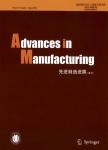Optimal machining conditions for turning Ti-6Al-4V using response surface methodology
Optimal machining conditions for turning Ti-6Al-4V using response surface methodology作者机构:Department of Mechanical EngineeringNational Institute of TechnologyWarangal
出 版 物:《Advances in Manufacturing》 (先进制造进展(英文版))
年 卷 期:2013年第1卷第4期
页 面:329-339页
核心收录:
学科分类:08[工学] 080502[工学-材料学] 0805[工学-材料科学与工程(可授工学、理学学位)]
主 题:Ti 6Al 4V Response surfacemethodology ~ Cutting force ~ Surface roughness
摘 要:Machining titanium is one of ever-increasing magnitude problems due to its characteristics such as low thermal conductivity, modulus of elasticity and work hardening. The efficient titanium alloy machining involves a proper selection of process parameters to minimize the tangential force (Fz) and surface roughness (Ra). In the present work, the performance of PVD/TiA1N coated carbide inserts was investigated using response surface methodology (RSM) for turning Ti-6A1-4V. The effects of process parameters such as speed (v), feed (/'), depth of cut (d) and back rake angle (Ty) on Fz and Ra were investi- gated. The experimental plan used for four factors and three levels was designed based on face centered, central composite design (CCD). The experimental results indi- cated that Fz increased with the increase in d, f and decreased with the increase in v and yy, whereas Ra decreased with the increase in v and 7y, and increased with d and v. The goodness of fit of the regression equations and model fits (R2) for Fz and Ra were found to be 0.968 and 0.970, which demonstrated that it was an effective model. A confirmation test was also conducted in order to verify the correctness of the model.



